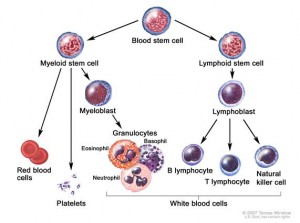“Officer and a Gentleman” actress, Lisa Blount, battled blood disorder before her death

Academy Award-winning producer and actress, Lisa Blount, has died at the age of 53. The actress is perhaps best known in her role as Debra Winger’s friend, Lynette Pomeroy, in 1982’s An Officer and a Gentleman. She also won an Academy Award for producing a live-action short film called The Accountant. According to her mother, Louise Blount, Lisa has suffered from a blood disorder called idiopathic thrombocytopenic purpura for the past 17 years. Blount also told Radar Online: “I think that [ITP] might have been part of the problem when she passed away because when I found her she had a purple look on her neck that looked like blood on the surface… We think she died very sudden. She had her phone in her hand and her bed was not disturbed.” Lisa Blount had recently been filming in Nashville for a TV pilot on Fox called Outlaw Country.
What Is Idiopathic Thrombocytopenic Purpura? (Source: NHLBI)
 Idiopathic thrombocytopenic purpura (ITP) is a bleeding condition in which the blood doesn’t clot as it should. This is due to a low number of blood cell fragments called platelets, which are also are called thrombocytes. They are made in the bone marrow along with other kinds of blood cells. Platelets stick together (clot) to seal small cuts or breaks on blood vessel walls and stop bleeding.
Idiopathic thrombocytopenic purpura (ITP) is a bleeding condition in which the blood doesn’t clot as it should. This is due to a low number of blood cell fragments called platelets, which are also are called thrombocytes. They are made in the bone marrow along with other kinds of blood cells. Platelets stick together (clot) to seal small cuts or breaks on blood vessel walls and stop bleeding.
“Idiopathic” means that the cause of the condition isn’t known. “Thrombocytopenic” means there’s a lower than normal number of platelets in the blood. “Purpura” refers to purple bruises caused by bleeding under the skin.
Overview
People who have ITP often have purple bruises that appear on the skin or on the mucous membranes (for example, in the mouth). The bruises mean that bleeding has occurred in small blood vessels under the skin.
A person who has ITP also may have bleeding that results in tiny red or purple dots on the skin. These pinpoint-sized dots are called petechiae .

The photograph shows petechiae (red/purple dots) and purpura (bruises) in the skin. Bleeding under the skin causes the purple, brown, and red color of the petechiae and purpura.
People who have ITP also may have nosebleeds, bleeding from the gums when they have dental work done, or other bleeding that’s hard to stop. Women who have ITP may have menstrual bleeding that’s heavier than usual.
More extensive bleeding can cause hematomas, which is a collection of clotted or partially clotted blood under the skin. It looks or feels like a lump.
Bleeding in the brain as a result of ITP is very rare, but can be life threatening if it occurs.
In most cases, an autoimmune response is believed to cause ITP. Normally, our immune system is designed to recognize the difference between the body’s own cells and tissues and”foreign” substances such as the bacteria and viruses. An autoimmune disease is an illness in which the body mistakenly believes one’s own tissues as foreign, and mounts an immune response to get rid of it. In ITP, the immune system attacks and destroys its own platelets. The reason why this happens isn’t known.
Types of Idiopathic Thrombocytopenic Purpura
There are two types of ITP: acute (temporary or short-term) and chronic (long-lasting).
Acute ITP generally lasts less than 6 months. It mainly occurs in children, both boys and girls, and is the most common type of ITP. Acute ITP often occurs after an infection caused by a virus.
Chronic ITP is long-lasting (6 months or longer) and mostly affects adults. However, some teenagers and children can get this type of ITP. Chronic ITP affects women 2 to 3 times more often than men.
How Is Idiopathic Thrombocytopenic Purpura Treated?
Treatment for idiopathic thrombocytopenic purpura (ITP) is based on how much and how often a patient is bleeding and what is their platelet count. In some cases, treatment may not be needed.
Medicines often are used as the first course of treatment. Treatments used for children and adults are similar. Adults with ITP who have very low platelet counts or problems with bleeding often are treated.
Medicines
If adults or children who have ITP need treatment, medicines often are tried first. Corticosteroids, such as prednisone, are commonly used to treat ITP. These medicines, called steroids for short, help increase the platelet count by lowering the activity of the immune system. However, steroids have a number of side effects, and some people relapse (get worse) when treatment ends.
Some medicines used to help raise the platelet count are given through a needle inserted into a vein. These medicines include immune globulin and anti-Rh (D) immunoglobulin. If steroids, immunoglobulins, or splenectomy (see below) don’t help, two newer medicines—eltrombopag and romiplostim—can be used to treat ITP.
 Removal of the Spleen (Splenectomy)
Removal of the Spleen (Splenectomy)
If necessary, the spleen will be removed surgically. This organ is located in the upper left abdomen. The spleen is about the size of a golf ball in children and a baseball in adults. The spleen makes antibodies (proteins) that help fight infection. In ITP, these antibodies destroy platelets. If ITP hasn’t responded to steroids, removing the spleen will reduce the destruction of platelets. However, it also may make a patient more likely to get certain infections (especially pneumococcus). Before the surgery, a doctor may give vaccines to help prevent these infections.
Platelet Transfusions
Some people with ITP who have severe bleeding may need to have platelet transfusions and be hospitalized. Some people will need a platelet transfusion before having surgery. For a platelet transfusion, donor platelets from a blood bank are injected into the recipient’s bloodstream. This increases the platelet count for a short time.
For more information, click here to go to the Resounding Health Casebook on ITP.
























0 comments